Examining the 2016-17 U18 USNTDP
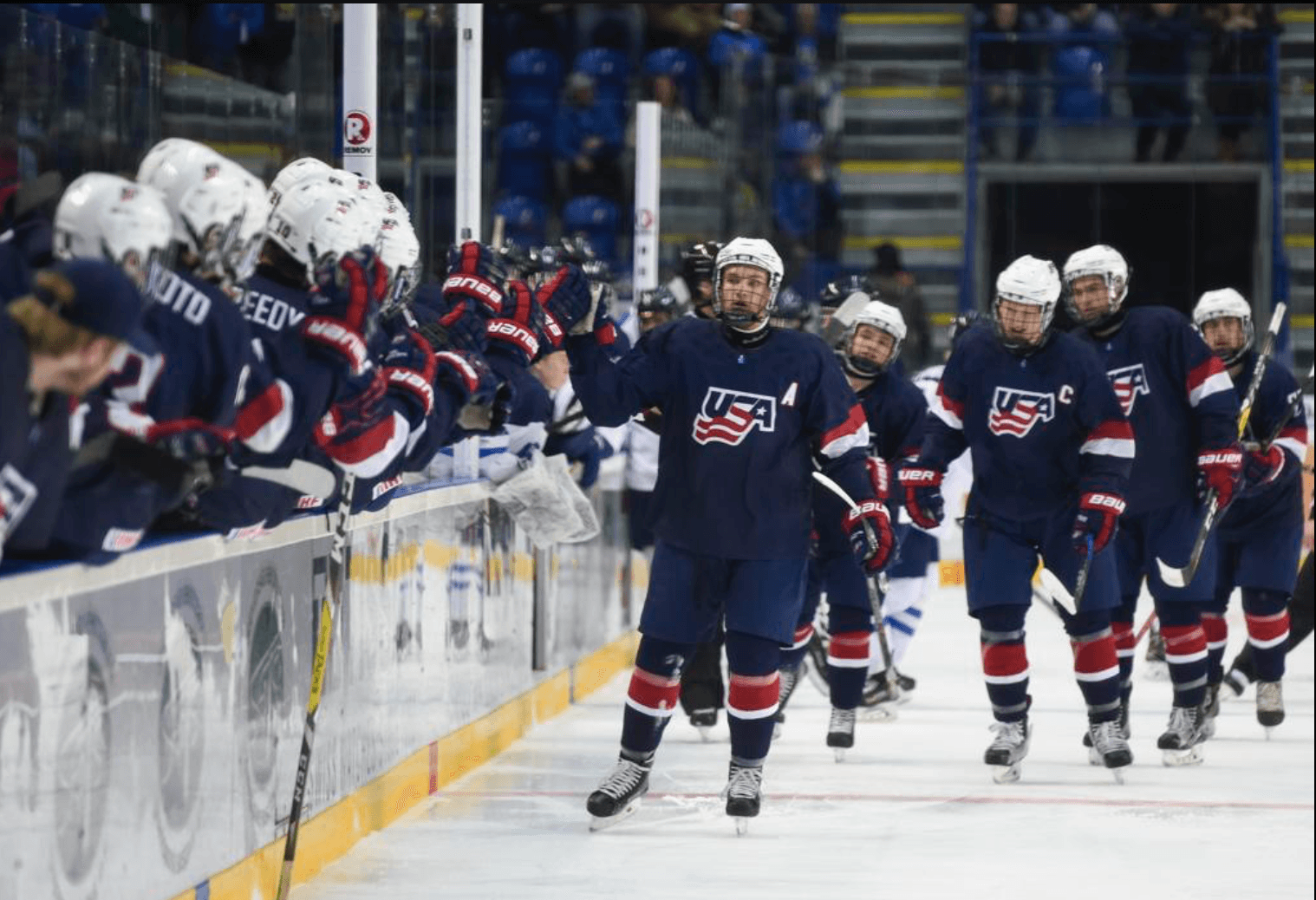
6 years ago
Earlier this year, analysts were effusive in their praise of Calgary Flames defensive prospect Adam Fox. Rightfully so, as he is a good prospect. It’s that they plucked him 66th overall that presents him as great value for the Flames with their third round selection.
There was a sentiment that he “came out of nowhere”, and he’s built his stock up since joining the Flames organization, and that’s absolutely fair. For others, this sentiment was confusing, as Fox was excellent for the United States National Development Team Program in his draft year. Fox’s being just 5’10” and 185 lbs probably didn’t help his cause, but the skill level was apparent to most.
Thinking about this got the wheels turning, and I wondered if the group of players from that program are generally undervalued a bit. Furthermore, how does this year stack up against others?
With that, we’ll explain what the USNTDP is, and Wikipedia sums it up perfectly:
The National Team Development Program (NTDP) was started in 1996 by USA Hockey as a way to identify elite ice hockey players in the country under the age of 18, and centralize their training. There are two teams in the program, an Under-17 squad and an Under-18 squad. The teams are both based in Plymouth Michigan. The stated goal of the NTDP is “to prepare student-athletes under the age of 18 for participation on U.S. National Teams and success in their future hockey careers. Its efforts focus not only on high-caliber participation on the ice, but creating well-rounded individuals off the ice.” While enrolled in the NTDP, players stay with billet families.
It’s fair to summarize that the USNTDP is identifying high-end American-born players and pushing them to excel. They then face USHL and NCAA teams throughout their development, while focusing on international tournaments like 5 Nations Cup, Ivan Hlinka, U17 WHJC and U18 WJHC. The U18 tournament in April is their Stanley Cup. It’s working. The US has won gold in seven of the last nine years (including this year) and won silver and bronze in the other two years.
Every year, most of the group does get drafted, but the success rate (and the names) of these groups are startling. Here are the stats for the 2016-17 U18 USNTDP, I’ve included all the games that they played this year except international tournaments:
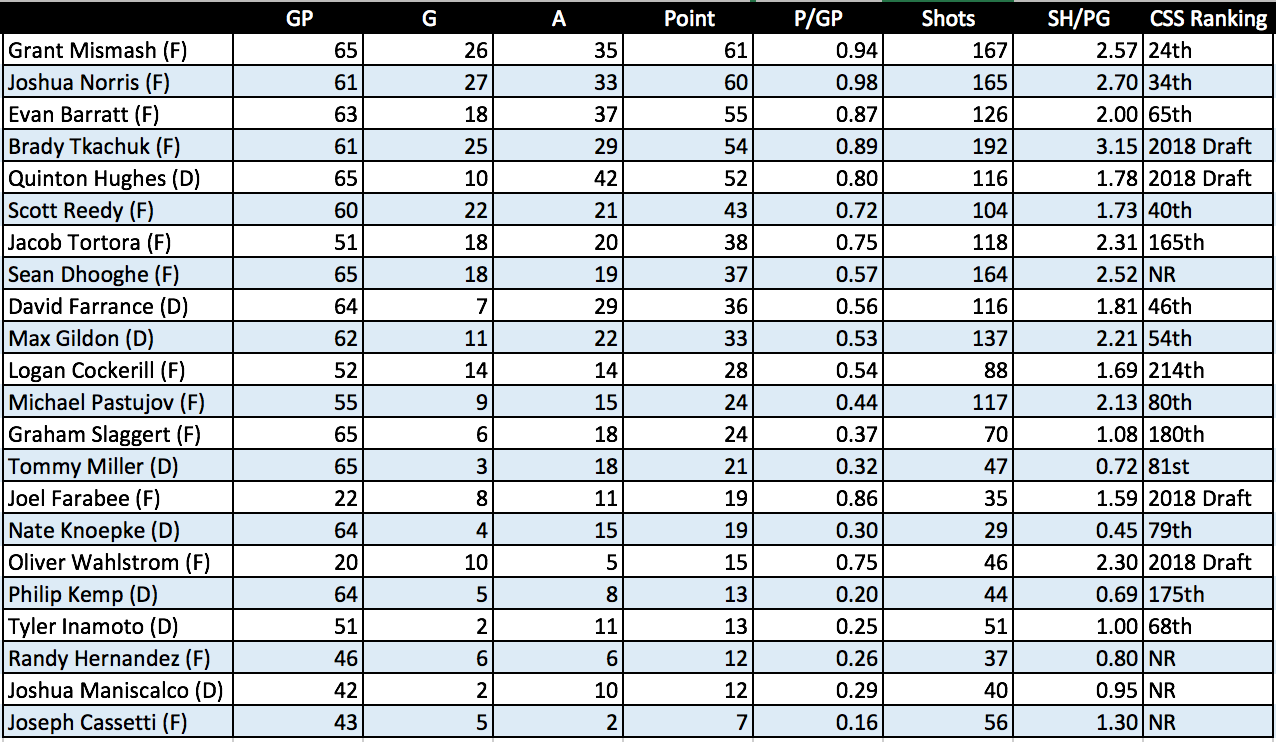
I’ve included the top 22 point getters for this year’s group. There are some 2018 players who were fixtures on this year’s team, including Brady Tkachuk, who misses the NHL draft cutoff by one day.
Forwards
We can now compare this year’s group to previous years, starting with the forwards, here are the top 36 point per game rates for the USNTDP since 2011-12 (I’ve excluded Joel Farabee, as he only appeared in 22 games):
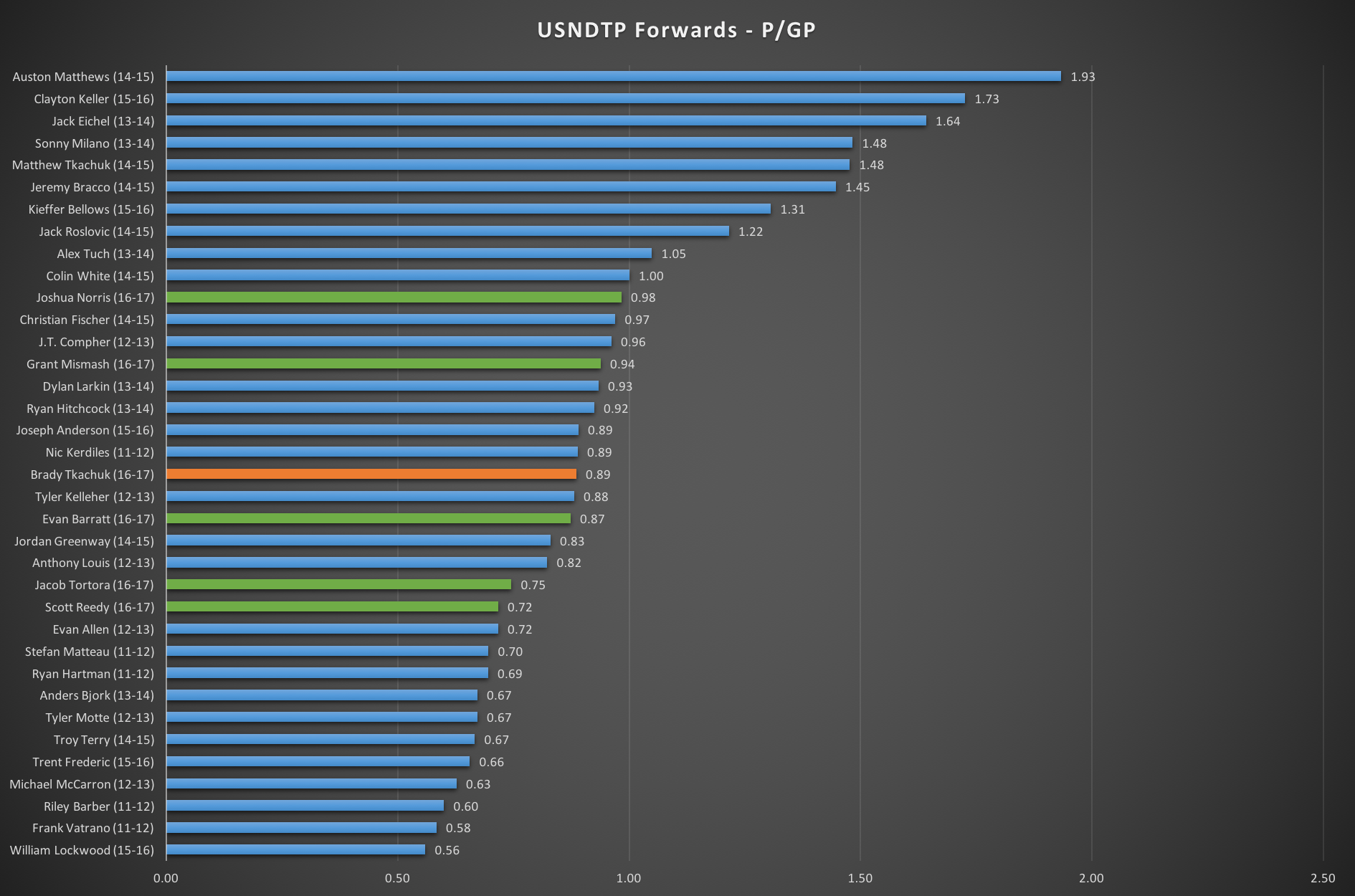
| Blue | Previous years |
| Green | 2017 Draft |
| Orange | 2018 Draft |
Obviously, there are no Auston Matthews (D-1), Clayton Keller or Jack Eichels in this group but Josh Norris and Grant Mismash are in fairly good company with Christian Fischer and J.T. Compher between them.
I’m curious about Tkachuk (D-1) going forward as he is being touted as a top five pick in the 2018 NHL Entry draft but falls fairly far down when compared to other years. If he were one day older, he would’ve been included in this class and doesn’t compare to favourable to even his own peer group, let alone his brother Matthew who put 1.48 PPG in his draft minus one year. Brady is committed to Boston University for next season.
Jacob Tortora is ranked 160th amongst N.A. skaters mostly due to his size as he is only 5’8″ and 160 lbs. It’s hard to know if he will hear his name called, but it wouldn’t be surprising for a team to take the “risk” on a smaller forward like Tortora and hope that the long term development path of the NCAA (he is committed to Boston College) will help round out his game enough to overcome the smaller size.
Evan Barratt, who is ranked 65th amongst North American skaters by CSS, and Scott Reedy, who is ranked 40th, present intriguing options in the middle rounds. Reedy is 6’1 and 203 lbs, so he has the frame to be an NHL player. Unfortunately, he didn’t have a great U18, so his stock may have fallen. He is committed to University of Minnesota
On the other side, Barratt had a noticeable U18s with one goal and five assists in seven games. Measuring in at 5’11” and 187 lbs, he is a bit smaller – he will attend Penn State University next season. He has the makings of a player who could provide good value. We have him ranked much higher than most other services.
Defencemen
This was the reason why I wanted to explore the group a bit further, just to see how Fox compared to everyone else. Based solely on PPG, he was a cut above:

| Blue | Previous years |
| Green | 2017 Draft |
| Orange | 2018 Draft |
Quinton Hughes is a projected top ten pick in the 2018 NHL Entry Draft, Bode Wilde (who isn’t on there) is also expected to go in the top ten next year. From this draft class, David Farrance and Max Gildon make appearances. Farrance is ranked 46th amongst N.A. skaters, while Gildon is 54th.
The closest players to those two are Will Butcher, Seth Jones and Chad Krys. Jones moved to the Winterhawks for his draft season, as the season above was his D-1. Butcher and Krys were in their draft season. Butcher fell to the 5th round, while Krys was snapped up in the mid second at the 2016 NHL Entry Draft.
We had Gildon ranked as the 60th best prospect in this draft, while Farrance checked in at 63rd overall. With that said, when using the USHL numbers, Gildon’s pGPS showed a success rate of 45.1%. That is very high considering where he is ranked.
Gildon is a player I am particularly high on in my appraisal. He has the size, mobility and well-rounded game to be a steal in the late second round.
More Stats
Unfortunately, I could only track down the shot data for this year and thus unable to compare to other years, but it still provides an interesting insight. Orange ones are the 2018 draft eligible guys
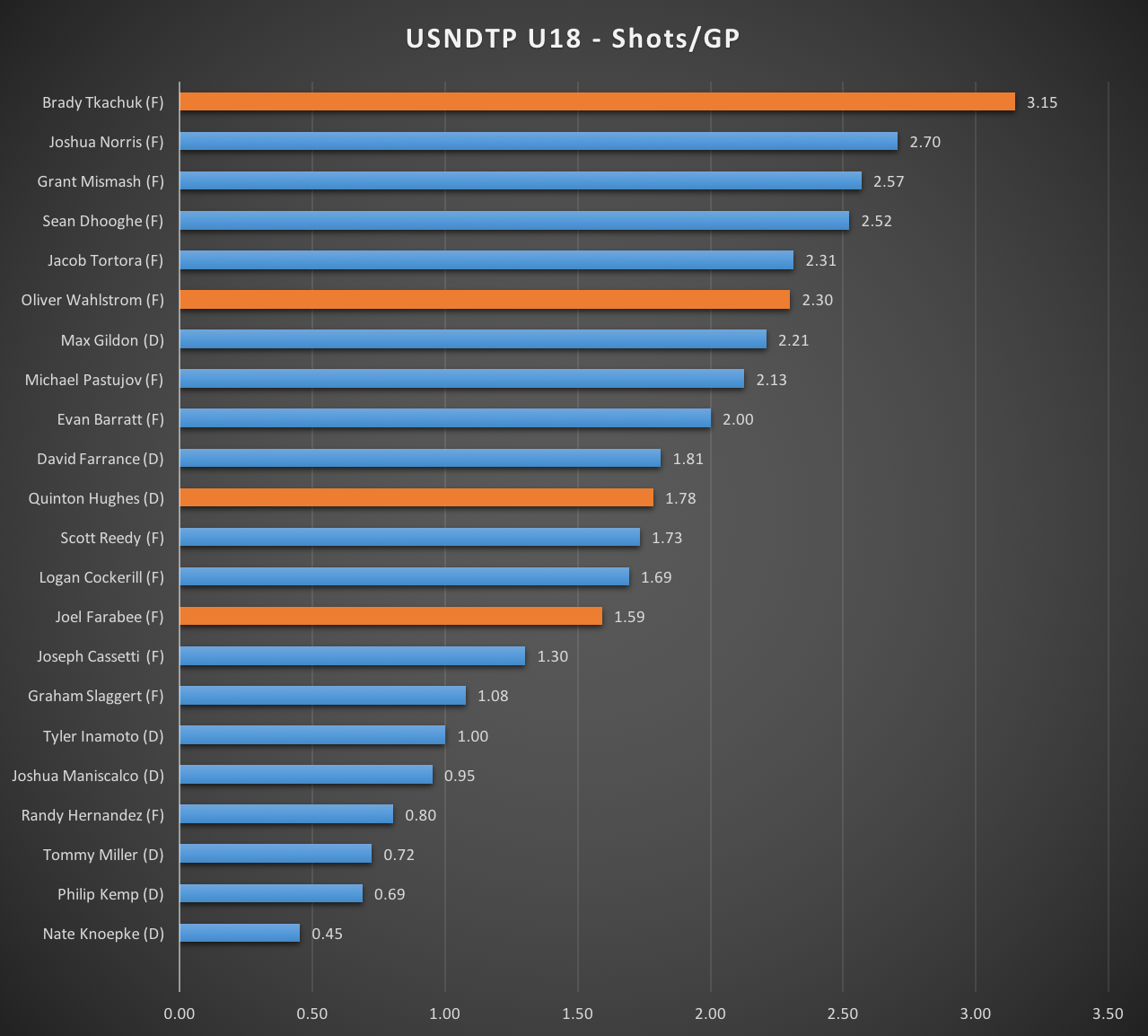
The usual suspects are near the top, as Gildon separates himself from Farrance by 0.40 shots per game. Sean Dhooghe is 5’3″ and 140 lbs, so despite having a good U18 tournament and decent shot rates, fell in PPG.
Thankfully, prospect-stats.com does track USHL game, which would include the USNTDP game vs. USHL competition. That gives us a look at the primary/secondary point breakdown amongst this group.
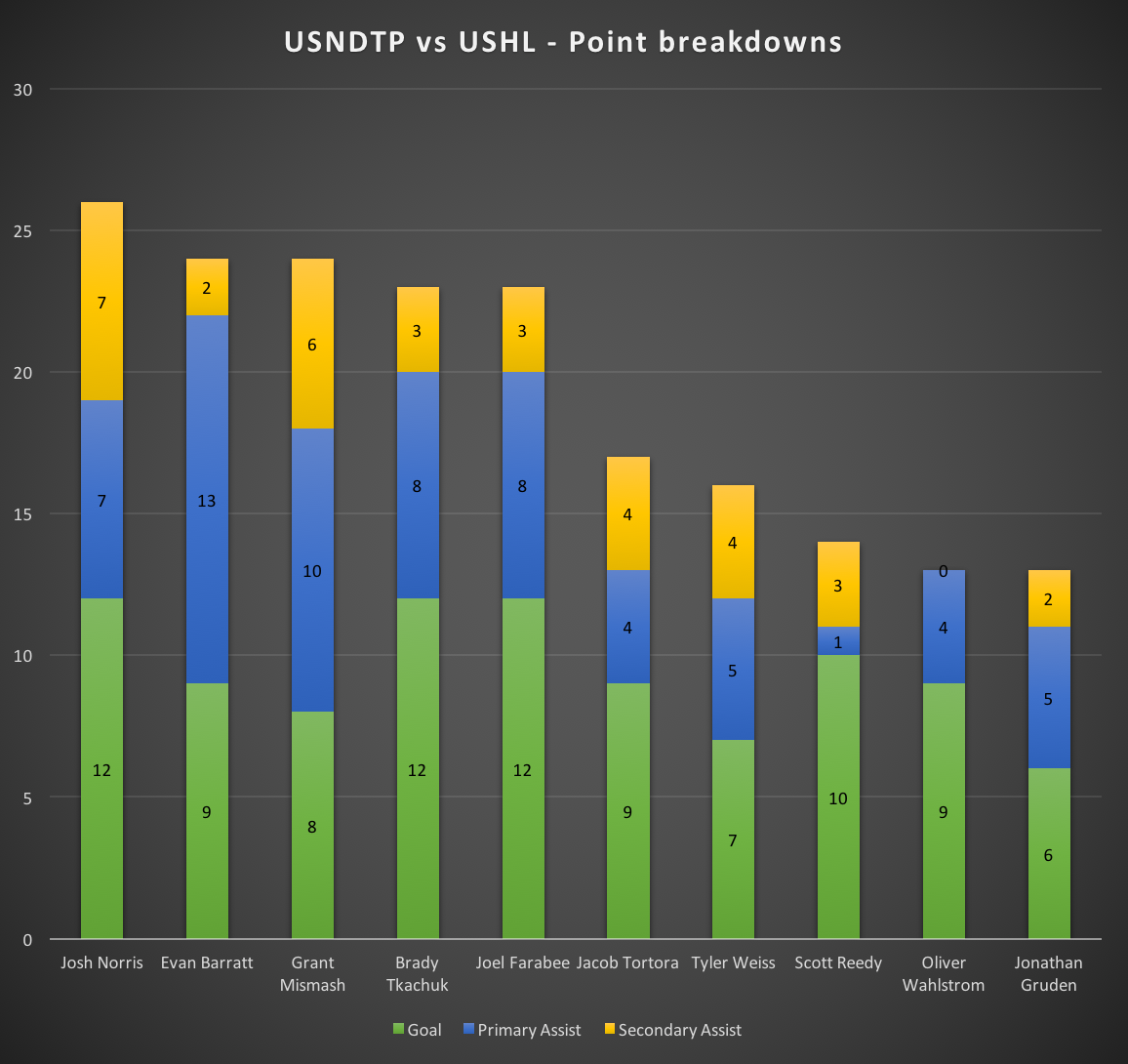
For the sake of clarity, I went with the top 10 point getters in that forward group. Barratt was a driver of offence with only two secondary assists, while Norris had 27% of his production from secondary assists.
On the back-end, the top five point getters are in stark contrast
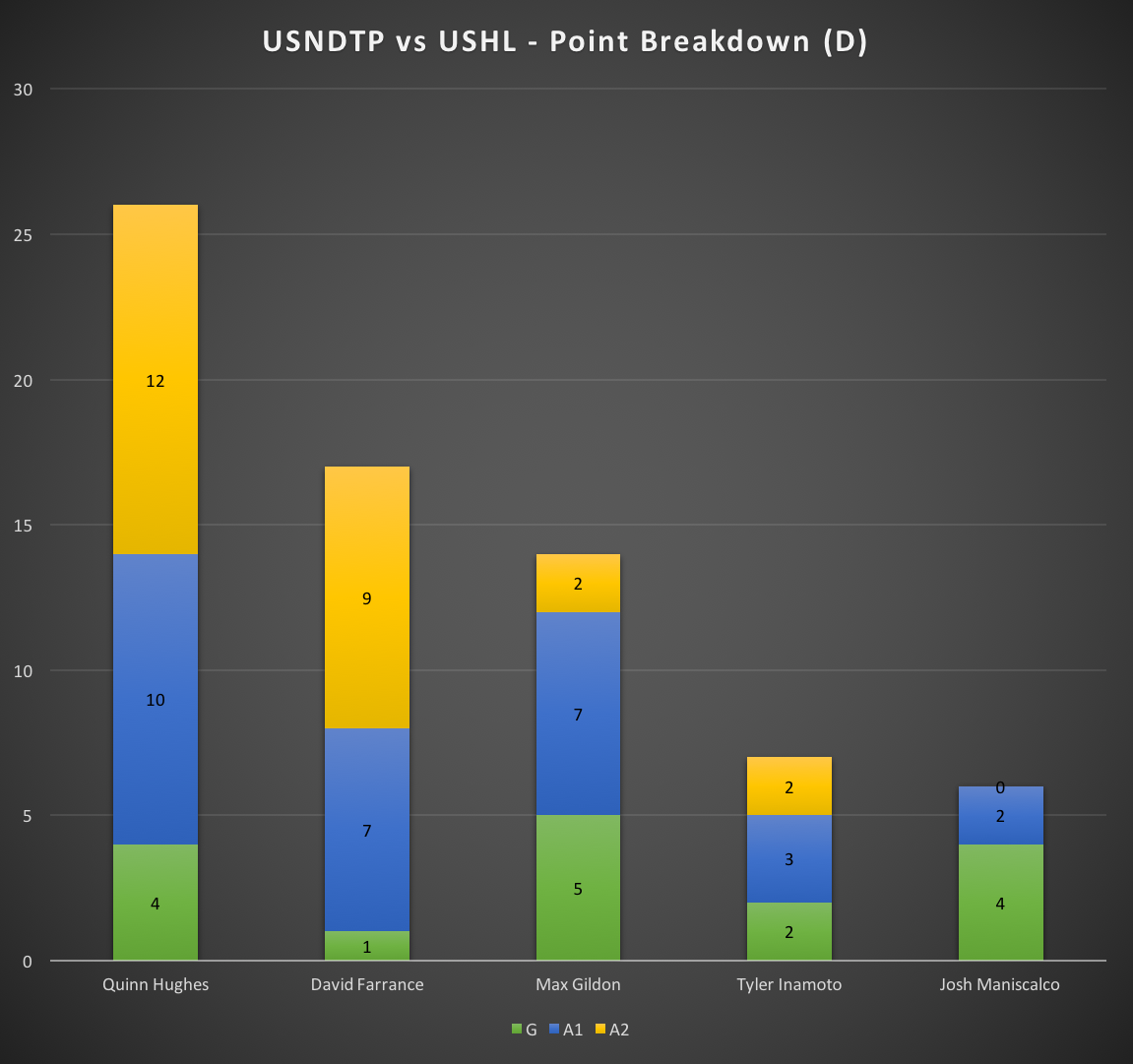
Hughes with a huge lead in point production, but quite a bit of secondary points. Although Gildon is third in production in the games against USHL teams – he only had two secondary assists.
As always with primary vs. secondary assists, they shouldn’t be used as the be all end all, but just another angle. But that angle shines a good light on Barratt and Gildon, both of which may be slightly undervalued.
pGPS
At this time, I only have the players that were featured in the Top 100 at my disposal, but figured it was worth including their data in one spot.

Those numbers are based on their performance in the USHL games. With the exception of Cockerel, based on where the players are ranked they all present interesting pGPS numbers and success rates. Norris and Gildon leading the group as very good value bets.
Conclusion
It’s clear that Hughes is in the conversation as top ten pick next year. Despite some higher than desirable secondary production in the games against the USHL, he generates shots and compares favourably to the top prospects regarding overall production.
As for Tkachuk, he has the skill set that teams fawn over, but his production is a bit concerning when compared to other players over the years. Just a couple days older, and he is 2017 draft eligible. This isn’t to say that he isn’t a good player, but there are concerns to be had that will need to be further investigated from now and until June 2018. If he goes to the NCAA and lights it up, that will quickly remove those doubts.
For this draft class specifically, it appears that the perception of them suffered from the lack of superstars in the program this year. There wasn’t one or two players driving the bus. That led to more of a ‘scoring by committee’ approach and the rankings by NHL CSS appear to have been affected by that.
Norris and Mismash have been in the conversation as late first round picks or second round picks, and rightfully so. Although they won’t wow you with their skill-sets, they appear to be trending towards being NHL players.
Barratt and Gildon appear to be the players that will provide the most value for where they are projected to go. Obviously, they could early, as it just takes one team to like them. It’s easy to see that in 6-8 months, there will be some articles saying ‘how did these guys fall?’.
Last month, I wrote about how biases needed to be eliminated and should avoid focusing one certain program. That is correct, but if there is evidence that shows that a particular path shows a better success rate, then you need to take advantage of that.
Looking back at WHO has come out of the USNTDP and how high the success rate is, should be something that makes teams taking a double take. Rather than taking someone because they play in the CHL and are ‘big’ should be the first thing to be eliminated and look towards programs like the USNTDP for the skilled players that year after year ‘come out of nowhere’.





